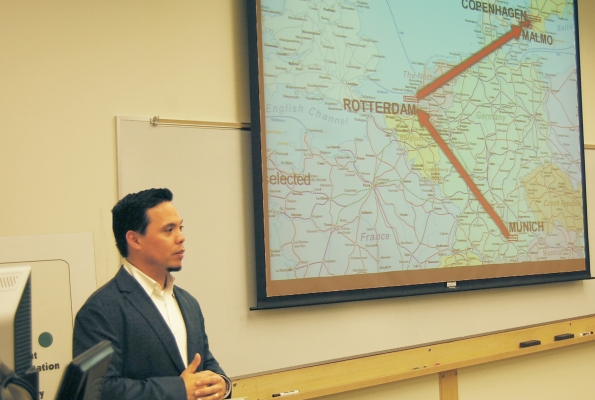Streets as places to stop and stay: lessons from Europe

While the public street system makes up a huge portion of our public space, streets don’t contribute less to public life than they could, Denver Igarta of the Portland Bureau of Transportation told an OTREC seminar April 12 in Portland.
That’s not the case in Europe, said Igarta, a multimodal urban planner and a principal author of the Portland Bicycle Plan. He spent last November on a fellowship in Europe sponsored by the German Marshall Fund, with a week each in Munich, Rotterdam, Copenhagen and Malmö.
While street design manuals in the United States largely consider how directly and smoothly a street moves people along their route and to a destination, many European streets serve another official function, Igarta said: they encourage people to stay and live their public lives. European urban streets fill some of the same roles as American urban parks: attractive places to spend time.
This especially holds for small neighborhood streets, Igarta said, where moving traffic is secondary to fostering public life.
Igarta demonstrated the type of planning that can create livable streets with a comparison between German and American standards. Under Germany’s national street-construction manual, designers first consider whether the street’s highest emphasis should be on moving traffic, creating an attractive public place or parking. Other considerations then follow, Igarta said, including how wide to make the street.
In the United States, most cities do the opposite: they start with the maximum width of the street and then determine its use.  The discussion ends up as “how much can we fit on this street?” instead of asking how wide a street needs to be to serve its primary function, Igarta said.
The discussion ends up as “how much can we fit on this street?” instead of asking how wide a street needs to be to serve its primary function, Igarta said.
Portland and other cities have much to learn from the European cities Igarta visited, he said. Transportation leaders can follow three principles to make their streets more livable:
First, they can design streets to encourage people to stop and stay, rather than just pass through. Second, they can work to make walking and cycling the best option for short trips. Third, they can resize streets to be experienced at the slower pace of a walker or cyclist rather than for the blur a driver sees.
Portland has already taken some of these steps, Igarta said, with plans such as the Portland Bicycle Plan, which emphasize human-powered short trips. Plenty of work remains, however, to make streets a place where people can create community.
- Read more about Igarta's studies in Europe on his blog
- Read an (unofficial) draft of his short research paper about livable streets in Germany, the Netherlands, Denmark and Sweden
